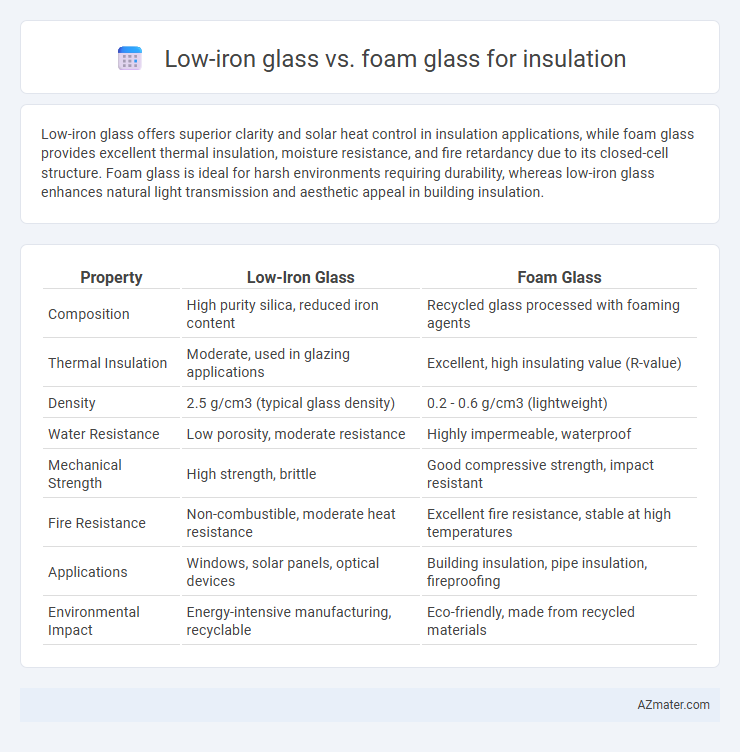Low-iron glass offers superior clarity and solar heat control in insulation applications, while foam glass provides excellent thermal insulation, moisture resistance, and fire retardancy due to its closed-cell structure. Foam glass is ideal for harsh environments requiring durability, whereas low-iron glass enhances natural light transmission and aesthetic appeal in building insulation.
Table of Comparison
| Property | Low-Iron Glass | Foam Glass |
|---|---|---|
| Composition | High purity silica, reduced iron content | Recycled glass processed with foaming agents |
| Thermal Insulation | Moderate, used in glazing applications | Excellent, high insulating value (R-value) |
| Density | 2.5 g/cm3 (typical glass density) | 0.2 - 0.6 g/cm3 (lightweight) |
| Water Resistance | Low porosity, moderate resistance | Highly impermeable, waterproof |
| Mechanical Strength | High strength, brittle | Good compressive strength, impact resistant |
| Fire Resistance | Non-combustible, moderate heat resistance | Excellent fire resistance, stable at high temperatures |
| Applications | Windows, solar panels, optical devices | Building insulation, pipe insulation, fireproofing |
| Environmental Impact | Energy-intensive manufacturing, recyclable | Eco-friendly, made from recycled materials |
Introduction to Low-Iron Glass and Foam Glass Insulation
Low-iron glass features ultra-clear properties due to its reduced iron content, enhancing light transmission and clarity compared to standard glass. Foam glass insulation consists of crushed recycled glass transformed into a lightweight, porous material with excellent thermal resistance and moisture protection. Both materials serve distinctive roles in building insulation, offering durability and energy efficiency tailored to specific construction needs.
Composition and Manufacturing Processes
Low-iron glass for insulation is primarily composed of silica with minimal iron oxide content, enhancing clarity and light transmission, and is manufactured through the melting and controlled cooling of high-purity raw materials. Foam glass insulation consists of crushed glass combined with foaming agents such as carbon or hydrocarbons, then heated to create a porous, cellular structure that provides excellent thermal resistance. While low-iron glass focuses on optical properties due to its refined chemical composition, foam glass emphasizes lightweight, durable insulation achieved by incorporating gas-filled pores during its manufacturing process.
Thermal Insulation Performance Comparison
Low-iron glass provides moderate thermal insulation with a typical R-value around 1.1 to 1.2 per inch, making it suitable for applications requiring transparency and moderate heat resistance. Foam glass demonstrates superior thermal insulation performance, offering R-values ranging from 3.6 to 4.0 per inch, due to its cellular structure that significantly reduces heat transfer. The choice between low-iron glass and foam glass depends on balancing transparency needs against higher thermal efficiency requirements in insulation projects.
Mechanical Strength and Durability
Low-iron glass offers moderate mechanical strength and durability, making it suitable for applications requiring transparency and thermal insulation with some load-bearing capacity. Foam glass exhibits superior mechanical strength and exceptional durability due to its cellular structure, providing excellent compressive resistance and long-term stability in harsh environments. When prioritizing insulation materials, foam glass outperforms low-iron glass in structural integrity and lifespan, especially in demanding industrial and construction settings.
Energy Efficiency and Environmental Impact
Low-iron glass offers superior clarity and solar heat control, enhancing energy efficiency by maximizing natural light while reducing cooling loads in buildings. Foam glass provides excellent thermal insulation, moisture resistance, and is made from recycled glass, significantly lowering environmental impact through sustainable production and durability. Both materials contribute to green building strategies, with low-iron glass improving daylighting and foam glass reducing heat transfer and waste.
Moisture Resistance and Vapor Permeability
Low-iron glass insulation offers moderate moisture resistance but tends to have higher vapor permeability, allowing some water vapor to pass through, which can affect thermal efficiency over time. Foam glass insulation provides superior moisture resistance with its closed-cell structure, effectively preventing water absorption and minimizing vapor transmission. This makes foam glass more suitable for environments with high humidity or direct exposure to moisture, ensuring long-term insulation performance.
Fire Resistance and Safety Ratings
Low-iron glass provides moderate fire resistance but typically falls short of the safety ratings offered by foam glass, which is highly fire-resistant and non-combustible. Foam glass insulation demonstrates superior performance in fire safety tests, exhibiting excellent thermal stability and preventing the spread of flames and smoke. These properties make foam glass a preferred choice in applications demanding stringent fire resistance and enhanced occupant safety.
Installation Methods and Versatility
Low-iron glass insulation typically requires specialized glazing techniques and precise framing to maximize its thermal and aesthetic properties, making installation more labor-intensive but allowing for sleek, transparent designs ideal for modern architectural applications. Foam glass insulation offers a more straightforward installation process with its lightweight, modular panels that can be easily cut and fitted into irregular spaces, providing excellent thermal resistance and moisture barrier capabilities. Foam glass's versatility extends to various construction types, including roofs, walls, and floors, while low-iron glass is primarily favored for facade and window insulation where clarity and light transmission are crucial.
Cost Analysis and Lifespan
Low-iron glass insulation offers higher transparency and aesthetic appeal but comes at a significantly higher initial cost compared to foam glass, which is more affordable and widely used for thermal insulation. Foam glass provides excellent durability and a typical lifespan exceeding 50 years, while low-iron glass insulation tends to have a lifespan of around 30 to 40 years, depending on installation and environmental conditions. Cost analysis favors foam glass for budget-sensitive projects due to its lower price and longer service life, despite lower clarity and design flexibility.
Applications and Suitability in Construction
Low-iron glass exhibits exceptional clarity and strength, making it ideal for architectural facades, windows, and skylights where natural light and aesthetic appeal are crucial. Foam glass insulation, characterized by its lightweight, thermal resistance, and moisture impermeability, suits building foundations, roofing, and floor insulation in both residential and commercial construction. Choosing between low-iron glass and foam glass depends on specific project requirements such as transparency needs versus thermal and moisture insulation priorities.

Infographic: Low-iron glass vs Foam glass for Insulation
 azmater.com
azmater.com